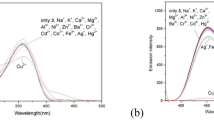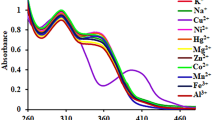Abstract
Pyranine as a new class of fluorescent chemosensor for the Cu+ ion is reported. The probe is capable of discriminating ranges of cations from the Cu+ ion, even in competing environment. The dye displayed a rapid fluorescence response (t1/2 = 1.66 min) towards the Cu+ ion, and the micromolar detection limit enabled the detection of the ion in environmental samples. The observed stoichiometry of complexation between pyranine and Cu+ was 2: 1. Interestingly, the sensing characteristic was specific to only neutral pH. A metal-to-ligand charge-transfer (MLCT)-based mechanism of sensing was proposed based on electron spin resonance (EPR), Raman spectroscopic and cyclic voltammetric studies.
Similar content being viewed by others
Notes and references
M. Taki, S. Iyoshi, A. Ojida, I. Hamachi, Y. Yamamoto, Development of Highly Sensitive Fluorescent Probes for Detection of Intracellular Copper(I) in Living Systems, J. Am. Chem. Soc., 2010, 132, 5938–5939.
C. Jegerschoeld, F. MacMillan, W. Lubitz, A. W. Rutherford, Effects of Copper and Zinc Ions on Photosystem II Studied by EPR Spectroscopy, Biochemistry, 1999, 38, 12439–12445.
D. R. Deshmukh, O. Mirochnitchenko, V. S. Ghole, D. Agnese, P. C. Shah, M. Reddell, R. E. Brolin, M. Inouye, Intestinal ischemia and reperfusion injury in transgenic mice overexpressing copper-zinc superoxide dismutase, Am. J. Physiol., 1997, 273, C1130–C1135.
H. H. A. Dollwet, J. R. J. Sorenson, Roles of copper in bone maintenance and healing, Biol. Trace Elem. Res., 1988, 18, 39–48.
A. B. G. Lansdown, Metal ions affecting the skin and eyes, Met. Ions Life Sci., 2011, 8, 187–246.
M. C. Linder, M. Hazegh-Azam, Copper biochemistry and molecular biology, Am. J. Clin. Nutr., 1996, 63, 797S–811S.
D. Y. Sasaki, D. R. Shnek, D. W. Pack, F. H. Arnold, Metal-induced dispersion of lipid aggregates: a simple, selective, and sensitive fluorescent metal ion sensor, Angew. Chem., Int. Ed Engl.., 1995, 34, 905–907.
J. Yoshii, H. Yoshiji, S. Kuriyama, Y. Ikenaka, R. Noguchi, H. Okuda, H. Tsujinoue, T. Nakatani, H. Kishida, D. Nakae, D. E. Gomez, M. S. de Lorenzo, A. M. Tejera, H. Fukui, The copper-chelating agent, trientine, suppresses tumor development and angiogenesis in the murine hepatocellular carcinoma cells, Int. J. Cancer, 2001, 94, 768–773.
L. Zeng, E. W. Miller, A. Pralle, E. Y. Isacoff, C. J. Chang, A Selective Turn-On Fluorescent Sensor for Imaging Copper in Living Cells, J. Am. Chem. Soc., 2006, 128, 10–11.
J. S. Valentine, P. J. Hart, Misfolded CuZnSOD and amyotrophic lateral sclerosis, Proc. Nat. Acad. Sci. U. S. A., 2003, 100, 3617–3622.
L. I. Bruijn, T. M. Miller, D. W. Cleveland, Unraveling the mechanisms involved in motor neuron degeneration in ALS, Annu. Rev. Neurosci., 2004, 27, 723–749.
K. J. Barnham, C. L. Masters, A. I. Bush, Neurodegenerative diseases and oxidative stress, Nat. Rev. Drug Discovery, 2004, 3, 205–214.
S. Yoon, E. Albers Aaron, P. Wong Audrey, J. Chang Christopher, Screening mercury levels in fish with a selective fluorescent chemosensor, J. Am. Chem. Soc., 2005, 127, 16030–16031.
S.-K. Ko, Y.-K. Yang, J. Tae, I. Shin, In Vivo Monitoring of Mercury Ions Using a Rhodamine-Based Molecular Probe, J. Am. Chem. Soc., 2006, 128, 14150–14155.
P. Jiang, Z. Guo, Fluorescent detection of zinc in biological systems: recent development on the design of chemosensors and biosensors, Coord. Chem. Rev., 2004, 248, 205–229.
K. Kikuchi, K. Komatsu, T. Nagano, Zinc sensing for cellular application, Curr. Opin. Chem. Biol., 2004, 8, 182–191.
X. Peng, J. Du, J. Fan, J. Wang, Y. Wu, J. Zhao, S. Sun, T. Xu, A Selective Fluorescent Sensor for Imaging Cd2+ in Living Cells, J. Am. Chem. Soc., 2007, 129, 1500–1501.
M. Taki, M. Desaki, A. Ojida, S. Iyoshi, T. Hirayama, I. Hamachi, Y. Yamamoto, Fluorescence Imaging of Intracellular Cadmium Using a Dual-Excitation Ratiometric Chemosensor, J. Am. Chem. Soc., 2008, 130, 12564–12565.
R. W. Tsien, R. Y. Tsien, Calcium channels, stores, and oscillations, Annu. Rev. Cell Biol., 1990, 6, 715–760.
G. Dacarro, P. Pallavicini, A. Taglietti, The pH controlled uptake/release of citrate by a tri-copper(II) complex, New J. Chem., 2008, 32, 1839–1842.
N. Shao, Y. Zhang, S. Cheung, R. Yang, W. Chan, T. Mo, K. Li, F. Liu, Copper Ion-Selective Fluorescent Sensor Based on the Inner Filter Effect Using a Spiropyran Derivative, Anal. Chem., 2005, 77, 7294–7303.
J. Jo, H. Y. Lee, W. Liu, A. Olasz, C.-H. Chen, D. Lee, Reactivity-Based Detection of Copper(II) Ion in Water: Oxidative Cyclization of Azoaromatics as Fluorescence Turn-On Signaling Mechanism, J. Am. Chem. Soc., 2012, 134, 16000–16007.
L. Yang, R. McRae, M. M. Henary, R. Patel, B. Lai, S. Vogt, C. J. Fahrni, Imaging of the intracellular topography of copper with a fluorescent sensor and by synchrotron X-ray fluorescence microscopy, Proc. Nat. Acad. Sci. U. S. A., 2005, 102, 11179–11184.
S. Park, H.-J. Kim, Highly selective and sensitive fluorescence turn-on probe for a catalytic amount of Cu(I) ions in water through the click reaction, Tetrahedron Lett., 2012, 53, 4473–4475.
J. Qi, M. S. Han, C.-H. Tung, A benzothiazole alkyne fluorescent sensor for Cu detection in living cell, Bioorg. Med. Chem. Lett., 2012, 22, 1747–1749.
O. S. Wolfbeis, E. Fuerlinger, H. Kroneis, H. Marsoner, Fluorimetric analysis. 1. A study on fluorescent indicators for measuring near neutral (“physiological”) pH values, Fresenius’ Z. Anal. Chem., 1983, 314, 119–124.
E. Pines, D. Huppert, Observation of geminate recombination in excited state proton transfer, J. Chem. Phys., 1986, 84, 3576–3577.
R. Gepshtein, P. Leiderman, L. Genosar, D. Huppert, Testing the Three Step Excited State Proton Transfer Model by the Effect of an Excess Proton, J. Phys. Chem. A, 2005, 109, 9674–9684.
O. S. Wolfbeis, H. E. Posch, Fibre-optic fluorescing sensor for ammonia, Anal. Chim. Acta, 1986, 185, 321–327.
B. Muller, P. C. Hauser, Fluorescence optical sensor for low concentrations of dissolved carbon dioxide, Analyst, 1996, 121, 339–343.
R. MacQuarrie, Q. H. Gibson, Ligand Binding and Release of an Analogue of 2,3-Diphosphoglycerate from Human Hemoglobin, J. Biol. Chem., 1972, 247, 5686–5694.
P. S. Donnelly, S. D. Zanatta, S. C. Zammit, J. M. White, S. J. Williams, ‘Click’ cycloaddition catalysts: copper(i) and copper(ii) tris(triazolylmethyl)amine complexes, Chem. Commun., 2008, 2459–2461.
P. Barathi, A. Senthil Kumar, Electrochemical Conversion of Unreactive Pyrene to Highly Redox-Active 1,2-Quinone Derivatives on a Carbon Nanotube-Modified Gold Electrode Surface and Its Selective Hydrogen Peroxide Sensing, Langmuir, 2013, 29, 10617–10623.
J.-M. Zen, H.-H. Chung, A. S. Kumar, Selective Detection of o-Diphenols on Copper-Plated Screen-Printed Electrodes, Anal. Chem., 2002, 74, 1202–1206.
A. S. Kumar, Y.-M. Ji, S. Sornambikai, P.-Y. Chen, Y. Shih, Flow injection analysis of ellagic acid in cosmetic skin-whitening creams using a dendritic nanostructured copper-gold alloy plated screen-printed carbon electrode, Int. J. Electrochem. Sci., 2011, 6, 5344–5356.
Author information
Authors and Affiliations
Corresponding author
Additional information
† Electronic supplementary information (ESI) available: Additional experimental procedures, fluorescence spectra and cyclic voltammetry. See DOI: 10.1039/c4pp00097h
Rights and permissions
About this article
Cite this article
Saha, T., Sengupta, A., Hazra, P. et al. In vitro sensing of Cu+ through a green fluorescence rise of pyranine. Photochem Photobiol Sci 13, 1427–1433 (2014). https://doi.org/10.1039/c4pp00097h
Received:
Accepted:
Published:
Issue Date:
DOI: https://doi.org/10.1039/c4pp00097h




